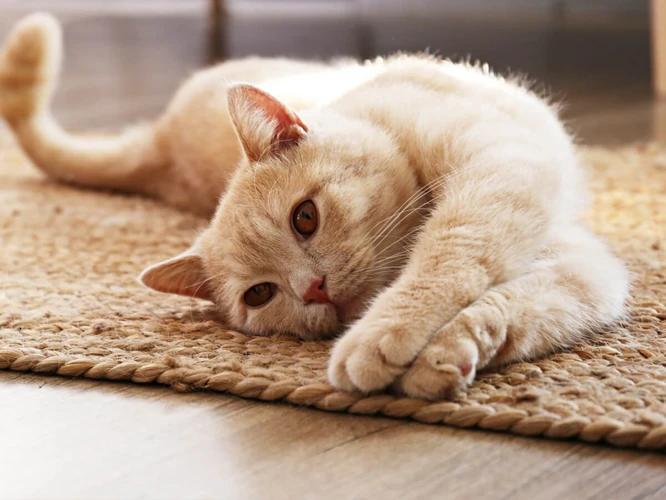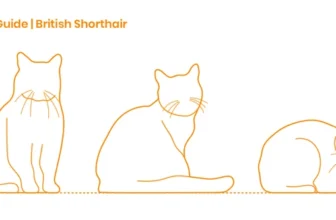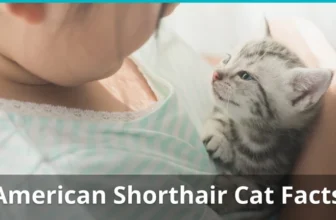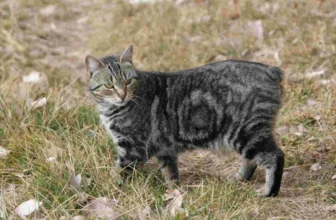Cats are adorable creatures that bring joy and companionship to our lives. As pet owners, we want to ensure that our cat is healthy and happy, with a long and fulfilling life. American shorthair cats are a popular breed, known for their friendly demeanor and playful personality. However, like all cats, they are susceptible to certain health problems that can affect their life expectancy. In this article, we will explore the five most common health problems that can impact the life expectancy of American shorthair cats. We will also discuss prevention and management strategies that can help your furry friend live a healthy and happy life. So, let’s dive in!
Common Health Problems

As much as we love our furry friends, it can be hard watching them suffer from any health condition. Unfortunately, certain health problems can have a significant impact on the life expectancy of American Shorthair Cats. We’ve compiled a list of the most common health problems that this breed faces. It’s essential to be aware of these issues and understand their potential effects. By doing so, you can take preventative measures and help your cat live a long and healthy life. So, let’s dive into the five health problems that can significantly affect your American Shorthair’s lifespan. If you want to learn more about factors affecting the life expectancy of shorthair cats, you can find it on our related article.
1. Obesity
Obesity is a common problem among American Shorthair cats and it can significantly affect their life expectancy. Overweight cats are more prone to developing health issues such as diabetes, arthritis, and heart disease. It’s important to monitor your cat’s weight to prevent obesity and ensure a healthy, happy life for your furry friend.
One of the main causes of obesity in cats is overfeeding. It’s crucial to provide your cat with the right amount of food based on their age, weight, and activity level. Overfeeding can lead to excessive weight gain, which can ultimately shorten your cat’s lifespan.
Additionally, lack of exercise can also contribute to obesity. It’s important to provide your cat with toys and encourage playtime to keep them active. Incorporating regular exercise into your cat’s daily routine can help maintain a healthy weight and reduce the risk of developing obesity-related health problems.
Prevention and management tips for obesity in American Shorthair cats:
- Feed a well-balanced diet that meets your cat’s nutritional needs.
- Provide measured meals throughout the day instead of free-feeding.
- Avoid high-calorie treats and snacks.
- Encourage playtime and incorporate exercise into your cat’s daily routine.
Managing your cat’s weight is crucial to their overall health and life expectancy. By following a healthy diet and exercise plan, you can help prevent and manage obesity in your American Shorthair cat and promote a long, healthy life for your furry friend. For more information on factors that affect the life expectancy of American Shorthair cats, check out our guide.
2. Dental Disease
Dental disease is a common health problem that can affect the life expectancy of American Shorthair cats. It can cause discomfort, pain, and inflammation in the mouth, which can make it difficult for cats to eat and groom themselves. Untreated dental disease can also lead to more serious health conditions such as infections and organ damage, which can further impact a cat’s lifespan.
Common Dental Problems
There are several types of dental problems that can affect American Shorthair cats, including:
| Type of Dental Problem | Description |
|---|---|
| Gingivitis | Inflammation of the gums |
| Periodontitis | Inflammation of the tissues surrounding the teeth |
| Tooth Resorption | Destruction of the tooth structure, leading to root exposure and pain |
| Oral Cancers | Tumors that can develop in various areas of the mouth |
Signs and Symptoms of Dental Problems
It’s important for cat owners to monitor their cat’s dental health regularly. Signs of dental disease may include bad breath, difficulty eating, drooling, bleeding gums, and loose or missing teeth. If you notice any of these symptoms, it’s important to take your cat to the vet for an examination.
Prevention and Management of Dental Problems
There are several things you can do as a cat owner to prevent and manage dental problems in American Shorthairs, including:
- Feeding a healthy diet that is high in protein and low in carbohydrates. This can help prevent plaque buildup and maintain good oral health.
- Providing your cat with chew toys or dental treats that can help remove plaque from their teeth.
- Brushing your cat’s teeth regularly, using a toothbrush and toothpaste designed specifically for cats.
- Taking your cat to the vet for regular dental check-ups, which may include professional cleanings and x-rays to detect any underlying issues.
By taking care of your American Shorthair’s dental health, you can help them live a longer, healthier life. For more information on how to estimate the life expectancy of American Shorthair cats, visit this article. You can also compare their life expectancy to other cat breeds in this comprehensive guide. To learn more about the nutrition tips for shorthair cats, visit this article.
3. Feline Lower Urinary Tract Disease (FLUTD)
Feline Lower Urinary Tract Disease, commonly referred to as FLUTD, is a health problem that affects American Shorthair cats. This disease is often caused by inflammation of the bladder, urethra, or both. If left untreated, FLUTD can lead to serious complications that can ultimately affect the life expectancy of your cat. Here are some of the signs and symptoms of FLUTD that you should be aware of to ensure your cat receives timely treatment:
- Straining while urinating
- Urinating outside the litter box
- Pain while urinating
- Frequent trips to the litter box with little or no urine produced
- Blood in the urine
What causes FLUTD?
There are numerous factors that can contribute to the development of FLUTD in American Shorthair cats. These include stress, poor diet, and bacterial infections. In some cases, the exact cause of FLUTD may not be identified, making it difficult to determine the best course of treatment.
How is FLUTD treated?
Treatment for FLUTD depends on the cause of the disease. In some cases, medication may be prescribed to control pain and inflammation. In other cases, dietary changes may be recommended to prevent further flare-ups. Surgery may also be necessary in severe cases.
Preventing FLUTD
While not all cases of FLUTD can be prevented, there are steps you can take to minimize your cat’s risk of developing this disease. Here are some tips:
- Provide your cat with plenty of fresh water
- Feed your cat a high-quality, balanced diet
- Clean the litter box regularly
- Minimize stress in your cat’s environment
- Visit your veterinarian regularly for routine check-ups
By following these preventative measures and seeking prompt treatment for any signs or symptoms of FLUTD, you can help ensure your American Shorthair cat leads a healthy and happy life.
4. Hypertension
Hypertension, or high blood pressure, is a common health problem in American Shorthair cats that can lead to numerous complications and ultimately affect their life expectancy. This condition is often known as a “silent killer” as the symptoms are not easily noticeable until advanced stages.
There are several risk factors that can lead to high blood pressure in cats. These include age, obesity, anxiety, kidney disease, and thyroid disorder. In some cases, high blood pressure can be a secondary underlying health issue associated with other health problems.
If left untreated, hypertension can lead to complications such as blindness, heart disease, and kidney failure. It is important to monitor blood pressure in cats regularly, especially those that are at higher risk.
Some common symptoms of hypertension in cats are:
| Symptoms | Description |
|---|---|
| Seizures or fits | Uncontrolled movements of the head and limbs |
| Disorientation | Loss of balance, walking in circles |
| Blindness | Sudden vision loss or dilated pupils |
| Weight loss | Loss of appetite or sudden weight loss |
| Nosebleeds | Presence of blood in nasal discharge |
To prevent and manage hypertension in American Shorthair cats, owners need to make some necessary lifestyle changes. One of the most crucial things is to maintain a healthy weight and ensure the cat is on an appropriate diet as obesity is a common risk factor. Anxiety and stress should be minimized to keep the blood pressure under control.
Regular veterinary check-ups are essential to keep track of the cat’s blood pressure, especially if they have any underlying health conditions. Monitoring the cat’s diet and providing them with regular exercise can help prevent obesity and other health problems.
Hypertension can significantly affect the life expectancy of American Shorthair cats if left untreated. It is important to take preventive measures such as regular vet checks, maintaining a healthy weight, proper diet, and exercise to manage this condition.
5. Kidney Disease
Kidney disease is another prevalent issue among American Shorthair cats, and it can significantly impact their life expectancy. As the kidneys play a vital role in filtering out toxins from the body, any damage or malfunction in this organ can lead to severe health problems and a shortened lifespan.
Symptoms: The symptoms of kidney disease in cats can vary and may include increased thirst and urination, vomiting, weight loss, lethargy, and a poor coat condition. If you notice any of these signs, it’s crucial to take your furry friend to the vet immediately to determine the underlying cause and start treatment.
Causes: There are several factors that can contribute to kidney disease in American Shorthair cats. The most common causes include age, infections, genetic predisposition, and exposure to toxins or certain medications.
Treatment: Treatment for kidney disease in cats often involves a combination of medication, dietary modifications, and fluid therapy. Your veterinarian may also recommend regular monitoring of your cat’s kidney function to catch any complications early on.
Prevention: While not all forms of kidney disease can be prevented, there are several steps you can take to reduce your cat’s risk. This includes feeding them a high-quality diet, ensuring they stay hydrated, and avoiding exposure to harmful toxins.
Conclusion: Kidney disease is a serious health issue that can impact the life expectancy of American Shorthair cats. As a responsible cat owner, it’s essential to keep an eye out for any symptoms of kidney disease and to provide them with the necessary care and treatment to keep them healthy and happy.
Prevention and Management
Now that we’ve discussed some of the most common health problems that can affect the life expectancy of American Shorthair cats, it’s crucial to explore prevention and management strategies. As the saying goes, “prevention is always better than cure”, and this is especially true for health concerns in pets. In this section, we’ll focus on the actionable steps that cat owners can take to maintain their feline friend’s health and prolong their lifespan. From providing a healthy diet to regular dental care, these tips will help keep your American Shorthair cat healthy and happy.
1. Feeding a Healthy Diet
Feeding a healthy diet is crucial for maintaining the overall health and life expectancy of American Shorthair cats. A diet that is high in protein, low in carbohydrates, and rich in essential nutrients ensures that the cat’s body stays healthy and functions properly.
Protein is especially important for cats, as they require a diet that is high in meat-based protein. This is because cats are obligate carnivores, meaning that their bodies are designed to digest and absorb nutrients from meat-based diets. A lack of protein in their diet can lead to muscle wasting, poor coat quality, and a weakened immune system.
Carbohydrates, on the other hand, should be minimized in a cat’s diet. Cats have a limited ability to digest carbohydrates, and consuming excess amounts can lead to obesity, diabetes, and other health problems.
Nutrients such as omega-3 fatty acids, taurine, and vitamin A are essential for maintaining good health and preventing disease. Omega-3 fatty acids, for example, help to reduce inflammation and promote good heart health. Taurine is essential for good eye and heart function, while vitamin A is important for maintaining healthy skin and coat.
To ensure that American Shorthair cats receive a healthy diet, it is important to choose high-quality cat food that is specifically formulated for their age, weight, and health needs. A diet that consists of high-quality proteins, complex carbohydrates, and plenty of vitamins and minerals can help prevent health issues and improve their overall quality of life.
Here is a table of recommended feeding guidelines for American Shorthair cats:
| Age | Feeding Frequency | Amount per Feeding |
|---|---|---|
| 0-6 months | 4-5 times per day | 1/4 – 1/3 cup |
| 6-12 months | 3 times per day | 1/3 – 1/2 cup |
| 1-7 years | 2 times per day | 1/4 – 1/3 cup |
| 7-10 years | 2 times per day | 1/4 – 1/3 cup |
| 10+ years | 2 times per day | 1/4 cup |
It is important to note that these are general guidelines, and the specific feeding requirements for each cat may vary based on their individual needs and activity levels. Consulting with a veterinarian can help determine the best diet plan for your cat.
2. Regular Dental Care
Dental care is essential for American Shorthair cats to maintain their oral hygiene and prevent common dental diseases such as gingivitis and periodontitis. Regular dental care should be a part of every cat owner’s routine to ensure their pet’s teeth stay healthy. Here are some tips for maintaining your cat’s dental health:
- Brush their teeth regularly: Regular brushing is an effective way to remove plaque and tartar buildup from your cat’s teeth. Start by using a soft-bristled toothbrush and specially formulated cat toothpaste. Brush your cat’s teeth gently in circular motions, paying attention to the gum line.
- Provide dental chews and toys: Dental chews and toys can help reduce plaque and tartar buildup by promoting chewing and saliva production. Look for products that carry the Veterinary Oral Health Council (VOHC) seal, which indicates they have been tested and proven to be effective.
- Avoid feeding your cat sugary or starchy food: Just like humans, cats can develop dental problems from consuming sugary or starchy food. Stick to a healthy diet that is low in carbohydrates and high in protein and fiber.
- Watch for signs of dental disease: Regularly check your cat’s teeth and gums for signs of dental disease, such as bad breath, red or bleeding gums, and loose or missing teeth. If you notice any of these signs, schedule a visit with your veterinarian.
- Do not ignore dental problems: If left untreated, dental problems can lead to pain, infection, and even tooth loss. It is important to get your cat’s dental problems treated as soon as possible to prevent further complications.
Regular dental care can not only help prevent dental diseases, but also contribute to your American Shorthair cat’s overall health and wellbeing. Incorporate these tips into your daily routine to ensure your cat has a healthy, happy smile.
3. Litter Box Management
Proper litter box management is crucial for maintaining the health and longevity of American Shorthair cats. Poor litter box habits can lead to urinary tract infections, bladder stones, and kidney disease, which can seriously impact a cat’s life expectancy.
- Keep the litter box clean:
- Use the right type of litter:
- Provide enough litter boxes:
- Choose the right location:
- Consult with your veterinarian on how often to check your cat’s blood pressure.
- Use a blood pressure monitor specifically designed for cats, since human monitors may not be accurate for feline readings.
- Maintain a calm and quiet environment during the blood pressure check, as stress and anxiety can increase blood pressure levels.
- Ensure that your cat is comfortable and relaxed during the procedure.
- If your cat is diagnosed with hypertension, your veterinarian may prescribe medications to manage the condition.
- Physical Examination: Your veterinarian will perform a thorough physical examination to assess your cat’s overall health, including their body condition, skin and coat health, and any noticeable lumps or bumps.
- Vaccinations: Your veterinarian will review your cat’s vaccination schedule, ensuring your cat is current on all necessary vaccinations for their age and lifestyle.
- Heartworm Prevention: Heartworms are transmitted by mosquitos and can cause serious heart and lung disease in cats. Your veterinarian will discuss heartworm prevention options and recommend a suitable preventative for your cat.
- Bloodwork: Routine bloodwork provides a sneak peek into how your cat’s body is functioning. Blood tests can identify early signs of issues such as kidney disease, liver dysfunction, or diabetes.
- Dental Examination: Dental disease can cause a host of health problems in cats. A dental exam can identify any potential issues with your cat’s teeth or gums.
- Fecal Examination: Fecal exams are essential in identifying intestinal parasites, which can cause a range of health problems in cats and humans.
- Behavioral Check: Your veterinarian will review any changes in your cat’s behavior, discuss any concerns, and offer recommendations for solutions.
- Additional Tests: Depending on your cat’s age, health history, and lifestyle, your veterinarian may recommend additional tests such as blood pressure monitoring, X-rays, or ultrasounds.
It’s important to clean the litter box daily to ensure that it’s sanitary for your cat. Scoop out feces and soiled litter, and replace it with fresh litter. A dirty litter box can cause your cat to avoid using it, which can lead to health problems.
American Shorthair cats can be particular about the type of litter they use, and using the wrong type can cause them to avoid the litter box. Try different types of litter to find the one that your cat prefers. You can use clay-based litters, plant-based litters or the common clumping litters.
Experts recommend having at least one litter box per cat, plus one extra. This ensures that each cat has enough space and privacy to use the litter box comfortably. Also, having multiple litter boxes prevents competition for the same one.
Place the litter box in a quiet, low-traffic area that is easily accessible for your cat. Avoid placing it near your cat’s food and water, as well as any appliances that make noise. It’s important to make it as private and stress-free as possible.
By following these litter box management tips, you can help prevent potentially serious health problems in your American Shorthair cat, which will ultimately lead to a longer and healthier life.
4. Monitoring Blood Pressure
Proper blood pressure monitoring is crucial for American Shorthair cats, as hypertension (high blood pressure) can have serious consequences on their overall health and life expectancy. Hypertension can cause damage to the kidneys, eyes, and heart, leading to organ failure and other serious issues.
To prevent hypertension in American Shorthair cats, it is important to monitor their blood pressure regularly. This can be done at home with the use of a blood pressure monitor designed for cats, or during vet visits. Regular monitoring will enable you to detect the early signs of hypertension and take action before it leads to more serious complications.
Here are some tips for monitoring your American Shorthair’s blood pressure:
By monitoring your American Shorthair cat’s blood pressure regularly and taking the necessary steps to manage hypertension, you can help prevent serious health issues and increase your cat’s life expectancy. Don’t hesitate to consult with your veterinarian for more information on blood pressure monitoring and management for your feline friend.
5. Regular Veterinary Check-Ups
Regular veterinary check-ups are crucial in keeping your American Shorthair cat healthy and potentially increasing their life expectancy. During these check-ups, your veterinarian will perform routine tests and evaluations to catch any potential health issues early on. Here are some steps that may be included in a regular veterinary check-up:
Regular veterinary check-ups are essential components of preventative healthcare. They offer an opportunity for your veterinarian to identify potential health problems before they become more severe and require intensive treatment. Scheduling routine check-ups is an excellent way to ensure your American Shorthair cat enjoys a long, healthy life.
Conclusion
After discussing the potential health problems that can affect the life expectancy of American Shorthair cats, it is clear that owners must take a proactive approach to ensure their cat’s well-being. Prevention and management measures such as feeding a healthy diet, providing regular dental care, managing litter boxes, monitoring blood pressure, and scheduling regular veterinary check-ups can all play a crucial role in helping to prevent or manage these health conditions.
It is also important for owners to be aware of the signs and symptoms associated with these health problems so that they can seek timely veterinary care. Early detection and intervention can make a significant difference in the outcome of these conditions, and even help to extend a cat’s lifespan.
In conclusion, while American Shorthair cats are generally considered to be a healthy breed, they are still vulnerable to certain health problems that can affect their life expectancy. Therefore, it is important to take a proactive approach to maintain their health and seek timely veterinary care when needed. By doing so, owners can help ensure that their furry friend lives the longest and healthiest life possible.
Frequently Asked Questions
1. What is the life expectancy of American Shorthair Cats?
The life expectancy of American Shorthair Cats is typically between 12-16 years, but some can live into their early 20s with proper care.
2. Can American Shorthair Cats develop dental disease?
Yes, dental disease is common in cats of all breeds, including American Shorthairs.
3. What are the signs of feline lower urinary tract disease?
The signs of feline lower urinary tract disease include urinating outside of the litter box, straining to urinate, and blood in the urine.
4. Can obesity really affect my American Shorthair’s life expectancy?
Yes, obesity can lead to a number of health problems in cats, including diabetes, arthritis, and heart disease, which can ultimately decrease their life expectancy.
5. Is hypertension common in American Shorthair Cats?
Yes, hypertension can affect cats of all breeds, including American Shorthairs.
6. Can feeding my American Shorthair a healthy diet prevent health problems?
Yes, feeding your cat a healthy and balanced diet can help prevent obesity, dental disease, and other health problems.
7. How often should I take my American Shorthair to the vet?
Your American Shorthair should receive an annual check-up with a veterinarian. If your cat has an underlying health condition, more frequent visits may be recommended.
8. What is the best way to manage my American Shorthair’s litter box?
Make sure to clean your cat’s litter box regularly and provide enough litter boxes for the number of cats in your home. Additionally, use unscented litter and avoid covered litter boxes.
9. Can I prevent kidney disease in my American Shorthair?
While kidney disease can have a genetic component, feeding your cat a healthy diet and providing regular veterinary care can help prevent or manage kidney disease.
10. Can I give my American Shorthair human food?
Feeding your cat human food is typically not recommended, as many human foods are not safe for cats and can lead to health problems.







